Curiosi di scoprire cosa vedere ad Amelia in un giorno? La nostra mini-guida vi condurrà alle antiche origini di Amelia, una piccola cittadina adagiata sulle colline umbro-laziali ricca di storia e tradizione! In un giorno.
A proteggere il centro storico, una vera perla del comprensorio, la cinta muraria di epoca romana. La costruzione di queste possenti mura ebbe inizio tra il III e VI secolo a.C., con blocchi di calcare massiccio poligonali incastrati a secco tra loro. Attualmente oggetto di restauro dopo il crollo di circa 30 m della cinta, avvenuto il 18 gennaio 2006, sono una testimonianza della grandezza della città, tra le più antiche d’Italia.
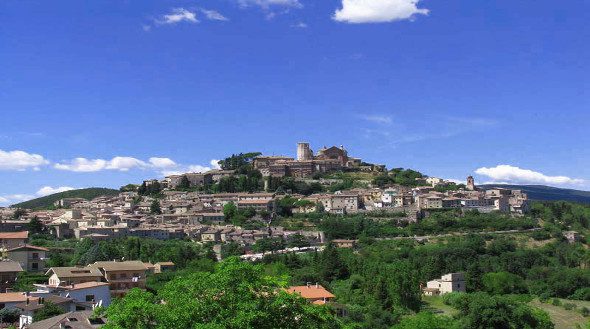
>>Vuoi visitare Amelia in un giorno? Consulta ora le offerte dei migliori agriturismi nelle vicinanze
Cosa vedere ad Amelia: passeggiare nel centro storico
Porta Romana rappresenta l’ingresso principale alla città murata, che in totale conta sei punti di accesso. Porta Romana risale al III secolo ma fu in parte ricostruita nel XVII.
Notevoli i palazzi rinascimentali siti in Amelia. In particolare, Palazzo Farattini costituisce un’importante opera di Antonio da San Gallo il Giovane di metà del IV secolo e rappresentò un vero e proprio studio preparatorio di quello che sarebbe diventato il più famoso Palazzo Farnese a Roma. Palazzo Farattini è il maggiore dei palazzi gentilizi “amerini della zona, ma segnaliamo anche il Palazzo Petrignani, di proprietà comunale e visitabile su richiesta, le cui decorazioni sono tradizionalmente attribuite alla scuola degli Zuccari.
Edificata nel XIV secolo, infine, è la chiesa di Sant’Agostino, caratterizzata da un maestoso portale a ogiva e da numerosi affreschi di Francesco Appiani.
Su Piazza Marconi, che conserva ancora parte dell’originaria pavimentazione, si affaccia la Loggia del Banditore: si tratta di una tipica tribuna da cui venivano emanati gli editti e letti i bandi alla popolazione. La loggia è sormontata da un orologio e affiancata da una particolare colonna, eretta nel 1479 in onore di Stefano Colonna.
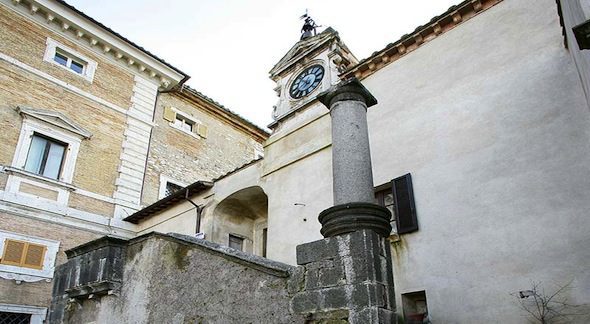
Proseguendo la passeggiata per i vicoli, si giunge fino in cima al paese dove è possibile ammirare la Torre civica dodecagonale risalente all’anno Mille e l’adiacente Cattedrale dedicata a Santa Fermina, Patrona di Amelia. Al suo interno stendardi sottratti ai turchi durante la battaglia di Lepanto (1571). Di fronte al duomo l’incantevole paesaggio offerto dal Belvedere.
Infine, a circa 4 km dal centro storico, situato nel cuore di un’area verde e abitato dai Frati Minori Francescani, segnaliamo il Convento della SS. Annunziata edificato nel XIV sec. La costruzione presenta un armonioso chiostro rinascimentale, mentre al suo interno è possibile ammirare una tela con L’Annunciazione di Domenico Bruschi (1890), autore anche degli affreschi della “Cappella del Transito” nel santuario della Porziuncola. Un’attrattiva di grande interesse artistico e religioso è il presepe permanente opera dell’artista spagnolo Juan Maria Oliva. È inoltre possibile visitare il Planetario situato nei pressi del convento.
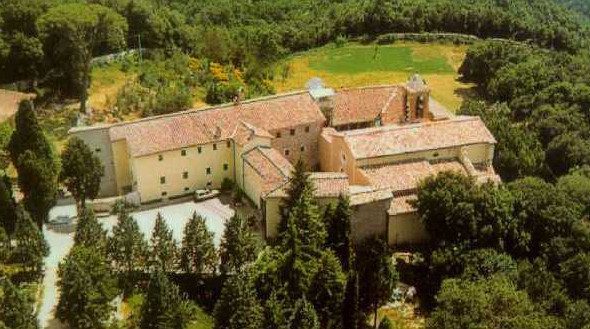
Cosa fare ad Amelia
Concluse le visite culturali di chiese ed edifici storici, cosa fare ad Amelia in un giorno?
Se vi piace andare per musei, proponiamo la visita al Museo Civico Archeologico e alla Pinacoteca “Edilberto Rosa”. Organizzato tematicamente all’interno dei tre piani, la raccolta è ospitata nell’ex Collegio Boccarini, in origine convento francescano del XIII-XIV secolo, dotato di chiostro a doppio loggiato realizzato nel XVI secolo. La sezione archeologica fornisce un panorama cronologicamente completo della storia di Amelia, dal periodo preromano a quello alto-medievale. Di notevole interesse è la statua bronzea con ritratto di Germanico, alta oltre 2,15 metri. La pinacoteca, collocata al secondo piano, conserva opere provenienti da chiese e palazzi locali, tra le quali si annoverano la tavola con Sant’Antonio Abate (1475), capolavoro di Pier Matteo d’Amelia, il “Cristo crocifisso tra i santi Firmina e Olimpiade” (1557), opera di Livio Agresti.
Altra grande attrazione turistica di epoca romana sono le Cisterne e l’ipogeo amerino, un insieme di cavità del sotterranee che i romani utilizzavano come via di fuga dalla città, come deposito o per la nota abilità nella progettazione degli impianti fognari e idraulici in generale.
Se volete conoscere meglio questo piccolo ma ricco borgo medievale e dei suoi tesori, vi consigliamo di approfittare di una visita guidata organizzata da Sistema Museo. L’itinerario “Amelia Millenaria” previsto ogni sabato pomeriggio, vi accompagnerà alla scoperta del centro storico, con ingresso alla torre civica oppure al teatro o al suggestivo Palazzo Petrignani.
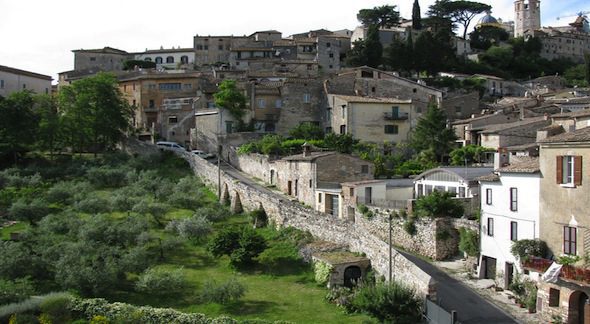
Cosa Mangiare ad Amelia
Un’interessante visita alle aziende agricole e cantine locali non può certo mancare nel vostro percorso! Numerose le aziende agricole della zona dove è possibile osservare come le coltivazioni avvengano nel pieno rispetto della natura e assaporare eccellenti produzioni biologiche come miele, marmellate e salse! Provate poi a stuzzicare il vostro appetito con olio extravergine d’oliva DOP locale e gli eccellenti vini DOC o IGT (come lo Sciurio, il Carbio e il Ciliegiolo..) e non ve ne pentirete!
Ottimi accompagnati da formaggi e salumi…meglio ancora se accostati a prelibati primi piatti ai funghi, agli asparagi o al tartufo nero! Carne alla brace, cinghiale e cacciagione completano il menu locale.
E cosa mangiare ad Amelia come dolce? Particolarmente gustosi, tipici dell’amerino, sono i Fichi Girotti. Fatti essiccare, tagliati e riempiti di condimento (cioccolato e canditi; cioccolato e mandorle tostate; cioccolato e noci) i fichi vengono poi passati sotto una pressa artigianale fino a formare una sorta di mattonella dalla forma rotonda. Ogni fase della lavorazione è eseguita rigorosamente a mano!
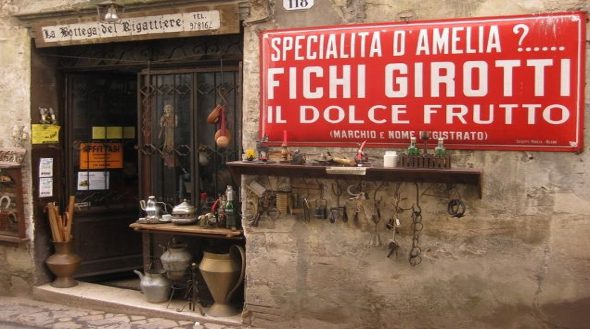
>>Consulta i ristoranti migliori nella zona di Amelia! Clicca e prenota
Are you curious to find out what to see in Amelia? Our mini-guide will show you the best things to do in Amelia, a small town nestled in the hills of Umbria and Lazio, rich in history and tradition!
The walls were built in the Roman period and the old town – the real pearl of the area “was protected by them. Currently being restored after the fall of about 30 meters of the boundary, which occurred on 18th January 2006, but they are a testimony to the greatness of the city, among the most ancient in Italy. You can access the city center by six gates and the main entrance is Porta Romana. It was built in III century, but it was partly rebuilt in the XVII.
In the city center there are many remarkable Renaissance buildings such as Farrattini Palace (mid-sixth century), the largest of the aristocratic residence in the area and Petrignani Palace. It is owned by the town and it can be visited on request and it shows decorations are attributed to the school of the Zuccari.
Built in the fourteenth century, St. Augustin’s Church is characterized by a majestic ogival portal and several frescoes by Francesco Appiani.
>> Do you want to visit Amelia? Check it out now of the best hotels in Amelia, Italy
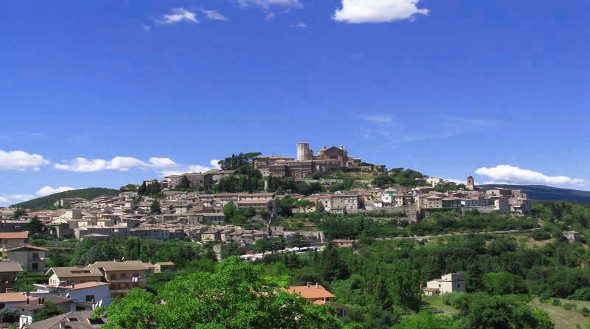
If you want to visit something about the Middle Ages, what can you do in Amelia? You can go to Piazza Marconi – it still retains the original flooring – and you can admire the Loggia of the Auctioneer, a typical medieval grandstand from which were issued the edicts and read the notices to the population. The loggia is topped by a clock and flanked by a column erected in 1479 in honor of Stefano Colonna.
Continuing the walk through the narrow streets, you come to the top of the village where you can admire the Civic Tower dating back to the year one thousand twelve-sided and the adjacent cathedral dedicated to Santa Fermina, Patroness of Amelia. In front of the cathedral you can enjoy the enchanting landscape offered by Belvedere.
About 4 km from the historic center, located in the heart of a green area and inhabited by the Franciscan Friars Minor, the Convent of SS. Annunziata. About 4 km from the historic center, located in the heart of a green area and inhabited by the Franciscan Friars Minor, the Convent of SS. Annunziata. it was built in the fourteenth century and presents a harmonious Renaissance cloister, while inside you can admire a painting of the Annunciation by Domenico Bruschi (1890), the author of the frescoes of the “Cappella del Transito” in the sanctuary of the Portiuncula. An attraction of great artistic and religious interest is the crib continuing work of Spanish artist Juan Maria Oliva. You can also visit the planetarium located near the convent.
>> Do you want to visit the Franciscan places nearby? Check it out now the best farmhouse in Amelia
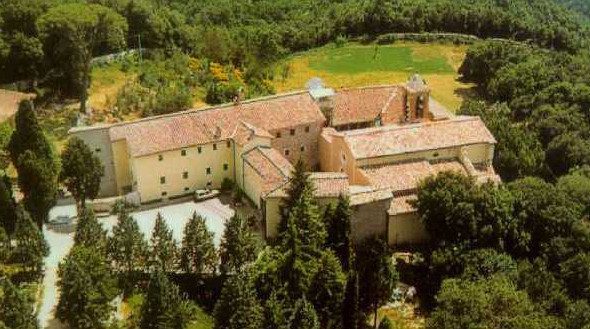
Things to do in Amelia, Italy
When you have finished the tour of the churches and historic buildings, if you are not too tired, there are other interesting things to do in Amelia!
Do you like to go to museums? if so, we suggest you to go and see the Archaeological Museum and the Art Gallery Edilberto Rosa housed in the former Boccarini College, an old Franciscan convent with a cloister double loggia built in the sixteenth century. The archaeological section provides an overview of the complete chronological story of Amelia, from pre-Roman times to the early Middle Ages. Of great interest is the bronze statue with a portrait of Germanicus, more than 2.15 meters high. The gallery, located on the second floor, contains works from local churches and palaces, among which include the table with Sant’Antonio Abate (1475) masterpiece by Pier Matteo d’Amelia, and “the crucified Christ and between Saints Firmina and Olympiad “(1557), by Livio Agresti.
Another great tourist attraction of the Roman period are the Cisterns and the underground Amelia: a set of subterranean cavities that Romans used as a way out from the city, as a deposit or as sewage and plumbing.
Amelia’s food, Umbrian cuisine, Italian food
An interesting visit to farms and local wineries can not miss in your route! There are many things to eat in Amelia and many farms where you can observe how the crops take place in full respect of nature and enjoy with excellent organic products such as honey, jams and sauces! Try to whet your appetite with extra virgin olive oil DOP and the excellent local wines DOC or IGT (as Sciurio, the Carbio and Ciliegiolo ..): you will not regret! They are excellent with cheeses and charcuterie… even better if they are combined with delicious pasta with mushroom sauce, asparagus and black truffles! Grilled meat, wild boar and wild game complete the local menu.
View the best restaurants in the area of Amelia! >> Click here and book.

What kind of sweet can you eat to Amelia? Particularly tasty are Girotti Figs. They are dried, cut and filled with condiments (chocolate and candied fruit, chocolate and toasted almonds, chocolate and walnuts). thereafter they are passed under a press artisan to form a kind of tile from the round shape. Each stage of the process is carried out by hand!
>> If you’ve decided to see Amelia and enjoy the local culinary specialties you should contact now farmhouses in its vicinity >> click this link.
Are you curious to find out what to see in Amelia? Our mini-guide will show you the best things to do in Amelia, a small town nestled in the hills of Umbria and Lazio, rich in history and tradition!
The walls were built in the Roman period and the old town – the real pearl of the area “was protected by them. Currently being restored after the fall of about 30 meters of the boundary, which occurred on 18th January 2006, but they are a testimony to the greatness of the city, among the most ancient in Italy. You can access the city center by six gates and the main entrance is Porta Romana. It was built in III century, but it was partly rebuilt in the XVII.
In the city center there are many remarkable Renaissance buildings such as Farrattini Palace (mid-sixth century), the largest of the aristocratic residence in the area and Petrignani Palace. It is owned by the town and it can be visited on request and it shows decorations are attributed to the school of the Zuccari.
Built in the fourteenth century, St. Augustin’s Church is characterized by a majestic ogival portal and several frescoes by Francesco Appiani.
>> Do you want to visit Amelia? Check it out now of the best hotels in Amelia, Italy

If you want to visit something about the Middle Ages, what can you do in Amelia? You can go to Piazza Marconi – it still retains the original flooring – and you can admire the Loggia of the Auctioneer, a typical medieval grandstand from which were issued the edicts and read the notices to the population. The loggia is topped by a clock and flanked by a column erected in 1479 in honor of Stefano Colonna.
Continuing the walk through the narrow streets, you come to the top of the village where you can admire the Civic Tower dating back to the year one thousand twelve-sided and the adjacent cathedral dedicated to Santa Fermina, Patroness of Amelia. In front of the cathedral you can enjoy the enchanting landscape offered by Belvedere.
About 4 km from the historic center, located in the heart of a green area and inhabited by the Franciscan Friars Minor, the Convent of SS. Annunziata. About 4 km from the historic center, located in the heart of a green area and inhabited by the Franciscan Friars Minor, the Convent of SS. Annunziata. it was built in the fourteenth century and presents a harmonious Renaissance cloister, while inside you can admire a painting of the Annunciation by Domenico Bruschi (1890), the author of the frescoes of the “Cappella del Transito” in the sanctuary of the Portiuncula. An attraction of great artistic and religious interest is the crib continuing work of Spanish artist Juan Maria Oliva. You can also visit the planetarium located near the convent.
>> Do you want to visit the Franciscan places nearby? Check it out now the best farmhouse in Amelia

Things to do in Amelia, Italy
When you have finished the tour of the churches and historic buildings, if you are not too tired, there are other interesting things to do in Amelia!
Do you like to go to museums? if so, we suggest you to go and see the Archaeological Museum and the Art Gallery Edilberto Rosa housed in the former Boccarini College, an old Franciscan convent with a cloister double loggia built in the sixteenth century. The archaeological section provides an overview of the complete chronological story of Amelia, from pre-Roman times to the early Middle Ages. Of great interest is the bronze statue with a portrait of Germanicus, more than 2.15 meters high. The gallery, located on the second floor, contains works from local churches and palaces, among which include the table with Sant’Antonio Abate (1475) masterpiece by Pier Matteo d’Amelia, and “the crucified Christ and between Saints Firmina and Olympiad “(1557), by Livio Agresti.
Another great tourist attraction of the Roman period are the Cisterns and the underground Amelia: a set of subterranean cavities that Romans used as a way out from the city, as a deposit or as sewage and plumbing.
Amelia’s food, Umbrian cuisine, Italian food
An interesting visit to farms and local wineries can not miss in your route! There are many things to eat in Amelia and many farms where you can observe how the crops take place in full respect of nature and enjoy with excellent organic products such as honey, jams and sauces! Try to whet your appetite with extra virgin olive oil DOP and the excellent local wines DOC or IGT (as Sciurio, the Carbio and Ciliegiolo ..): you will not regret! They are excellent with cheeses and charcuterie… even better if they are combined with delicious pasta with mushroom sauce, asparagus and black truffles! Grilled meat, wild boar and wild game complete the local menu.
View the best restaurants in the area of Amelia! >> Click here and book.

What kind of sweet can you eat to Amelia? Particularly tasty are Girotti Figs. They are dried, cut and filled with condiments (chocolate and candied fruit, chocolate and toasted almonds, chocolate and walnuts). thereafter they are passed under a press artisan to form a kind of tile from the round shape. Each stage of the process is carried out by hand!
>> If you’ve decided to see Amelia and enjoy the local culinary specialties you should contact now farmhouses in its vicinity >> click this link.
Are you curious to find out what to see in Amelia? Our mini-guide will show you the best things to do in Amelia, a small town nestled in the hills of Umbria and Lazio, rich in history and tradition!
The walls were built in the Roman period and the old town – the real pearl of the area “was protected by them. Currently being restored after the fall of about 30 meters of the boundary, which occurred on 18th January 2006, but they are a testimony to the greatness of the city, among the most ancient in Italy. You can access the city center by six gates and the main entrance is Porta Romana. It was built in III century, but it was partly rebuilt in the XVII.
In the city center there are many remarkable Renaissance buildings such as Farrattini Palace (mid-sixth century), the largest of the aristocratic residence in the area and Petrignani Palace. It is owned by the town and it can be visited on request and it shows decorations are attributed to the school of the Zuccari.
Built in the fourteenth century, St. Augustin’s Church is characterized by a majestic ogival portal and several frescoes by Francesco Appiani.
>> Do you want to visit Amelia? Check it out now of the best hotels in Amelia, Italy

If you want to visit something about the Middle Ages, what can you do in Amelia? You can go to Piazza Marconi – it still retains the original flooring – and you can admire the Loggia of the Auctioneer, a typical medieval grandstand from which were issued the edicts and read the notices to the population. The loggia is topped by a clock and flanked by a column erected in 1479 in honor of Stefano Colonna.
Continuing the walk through the narrow streets, you come to the top of the village where you can admire the Civic Tower dating back to the year one thousand twelve-sided and the adjacent cathedral dedicated to Santa Fermina, Patroness of Amelia. In front of the cathedral you can enjoy the enchanting landscape offered by Belvedere.
About 4 km from the historic center, located in the heart of a green area and inhabited by the Franciscan Friars Minor, the Convent of SS. Annunziata. About 4 km from the historic center, located in the heart of a green area and inhabited by the Franciscan Friars Minor, the Convent of SS. Annunziata. it was built in the fourteenth century and presents a harmonious Renaissance cloister, while inside you can admire a painting of the Annunciation by Domenico Bruschi (1890), the author of the frescoes of the “Cappella del Transito” in the sanctuary of the Portiuncula. An attraction of great artistic and religious interest is the crib continuing work of Spanish artist Juan Maria Oliva. You can also visit the planetarium located near the convent.
>> Do you want to visit the Franciscan places nearby? Check it out now the best farmhouse in Amelia

Things to do in Amelia, Italy
When you have finished the tour of the churches and historic buildings, if you are not too tired, there are other interesting things to do in Amelia!
Do you like to go to museums? if so, we suggest you to go and see the Archaeological Museum and the Art Gallery Edilberto Rosa housed in the former Boccarini College, an old Franciscan convent with a cloister double loggia built in the sixteenth century. The archaeological section provides an overview of the complete chronological story of Amelia, from pre-Roman times to the early Middle Ages. Of great interest is the bronze statue with a portrait of Germanicus, more than 2.15 meters high. The gallery, located on the second floor, contains works from local churches and palaces, among which include the table with Sant’Antonio Abate (1475) masterpiece by Pier Matteo d’Amelia, and “the crucified Christ and between Saints Firmina and Olympiad “(1557), by Livio Agresti.
Another great tourist attraction of the Roman period are the Cisterns and the underground Amelia: a set of subterranean cavities that Romans used as a way out from the city, as a deposit or as sewage and plumbing.
Amelia’s food, Umbrian cuisine, Italian food
An interesting visit to farms and local wineries can not miss in your route! There are many things to eat in Amelia and many farms where you can observe how the crops take place in full respect of nature and enjoy with excellent organic products such as honey, jams and sauces! Try to whet your appetite with extra virgin olive oil DOP and the excellent local wines DOC or IGT (as Sciurio, the Carbio and Ciliegiolo ..): you will not regret! They are excellent with cheeses and charcuterie… even better if they are combined with delicious pasta with mushroom sauce, asparagus and black truffles! Grilled meat, wild boar and wild game complete the local menu.
View the best restaurants in the area of Amelia! >> Click here and book.

What kind of sweet can you eat to Amelia? Particularly tasty are Girotti Figs. They are dried, cut and filled with condiments (chocolate and candied fruit, chocolate and toasted almonds, chocolate and walnuts). thereafter they are passed under a press artisan to form a kind of tile from the round shape. Each stage of the process is carried out by hand!
>> If you’ve decided to see Amelia and enjoy the local culinary specialties you should contact now farmhouses in its vicinity >> click this link.
Are you curious to find out what to see in Amelia? Our mini-guide will show you the best things to do in Amelia, a small town nestled in the hills of Umbria and Lazio, rich in history and tradition!
The walls were built in the Roman period and the old town – the real pearl of the area “was protected by them. Currently being restored after the fall of about 30 meters of the boundary, which occurred on 18th January 2006, but they are a testimony to the greatness of the city, among the most ancient in Italy. You can access the city center by six gates and the main entrance is Porta Romana. It was built in III century, but it was partly rebuilt in the XVII.
In the city center there are many remarkable Renaissance buildings such as Farrattini Palace (mid-sixth century), the largest of the aristocratic residence in the area and Petrignani Palace. It is owned by the town and it can be visited on request and it shows decorations are attributed to the school of the Zuccari.
Built in the fourteenth century, St. Augustin’s Church is characterized by a majestic ogival portal and several frescoes by Francesco Appiani.
>> Do you want to visit Amelia? Check it out now of the best hotels in Amelia, Italy

If you want to visit something about the Middle Ages, what can you do in Amelia? You can go to Piazza Marconi – it still retains the original flooring – and you can admire the Loggia of the Auctioneer, a typical medieval grandstand from which were issued the edicts and read the notices to the population. The loggia is topped by a clock and flanked by a column erected in 1479 in honor of Stefano Colonna.
Continuing the walk through the narrow streets, you come to the top of the village where you can admire the Civic Tower dating back to the year one thousand twelve-sided and the adjacent cathedral dedicated to Santa Fermina, Patroness of Amelia. In front of the cathedral you can enjoy the enchanting landscape offered by Belvedere.
About 4 km from the historic center, located in the heart of a green area and inhabited by the Franciscan Friars Minor, the Convent of SS. Annunziata. About 4 km from the historic center, located in the heart of a green area and inhabited by the Franciscan Friars Minor, the Convent of SS. Annunziata. it was built in the fourteenth century and presents a harmonious Renaissance cloister, while inside you can admire a painting of the Annunciation by Domenico Bruschi (1890), the author of the frescoes of the “Cappella del Transito” in the sanctuary of the Portiuncula. An attraction of great artistic and religious interest is the crib continuing work of Spanish artist Juan Maria Oliva. You can also visit the planetarium located near the convent.
>> Do you want to visit the Franciscan places nearby? Check it out now the best farmhouse in Amelia

Things to do in Amelia, Italy
When you have finished the tour of the churches and historic buildings, if you are not too tired, there are other interesting things to do in Amelia!
Do you like to go to museums? if so, we suggest you to go and see the Archaeological Museum and the Art Gallery Edilberto Rosa housed in the former Boccarini College, an old Franciscan convent with a cloister double loggia built in the sixteenth century. The archaeological section provides an overview of the complete chronological story of Amelia, from pre-Roman times to the early Middle Ages. Of great interest is the bronze statue with a portrait of Germanicus, more than 2.15 meters high. The gallery, located on the second floor, contains works from local churches and palaces, among which include the table with Sant’Antonio Abate (1475) masterpiece by Pier Matteo d’Amelia, and “the crucified Christ and between Saints Firmina and Olympiad “(1557), by Livio Agresti.
Another great tourist attraction of the Roman period are the Cisterns and the underground Amelia: a set of subterranean cavities that Romans used as a way out from the city, as a deposit or as sewage and plumbing.
Amelia’s food, Umbrian cuisine, Italian food
An interesting visit to farms and local wineries can not miss in your route! There are many things to eat in Amelia and many farms where you can observe how the crops take place in full respect of nature and enjoy with excellent organic products such as honey, jams and sauces! Try to whet your appetite with extra virgin olive oil DOP and the excellent local wines DOC or IGT (as Sciurio, the Carbio and Ciliegiolo ..): you will not regret! They are excellent with cheeses and charcuterie… even better if they are combined with delicious pasta with mushroom sauce, asparagus and black truffles! Grilled meat, wild boar and wild game complete the local menu.
View the best restaurants in the area of Amelia! >> Click here and book.

What kind of sweet can you eat to Amelia? Particularly tasty are Girotti Figs. They are dried, cut and filled with condiments (chocolate and candied fruit, chocolate and toasted almonds, chocolate and walnuts). thereafter they are passed under a press artisan to form a kind of tile from the round shape. Each stage of the process is carried out by hand!
>> If you’ve decided to see Amelia and enjoy the local culinary specialties you should contact now farmhouses in its vicinity >> click this link.

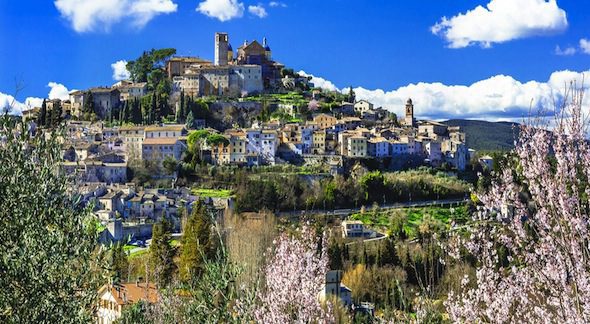







Comment (0)